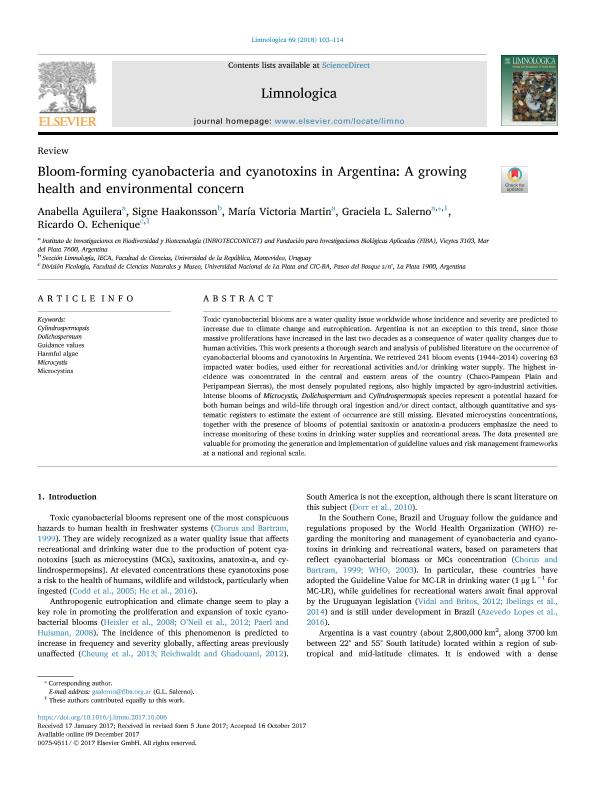Mostrar el registro sencillo del ítem
dc.contributor.author
Aguilera, Anabella

dc.contributor.author
Haakonsson, Signe
dc.contributor.author
Martin, María Victoria

dc.contributor.author
Salerno, Graciela Lidia

dc.contributor.author
Echenique, Ricardo Omar

dc.date.available
2019-11-08T13:10:43Z
dc.date.issued
2018-01
dc.identifier.citation
Aguilera, Anabella; Haakonsson, Signe; Martin, María Victoria; Salerno, Graciela Lidia; Echenique, Ricardo Omar; Bloom-forming cyanobacteria and cyanotoxins in Argentina: A growing health and environmental concern; Elsevier Gmbh; Limnologica; 69; 1-2018; 103-114
dc.identifier.issn
0075-9511
dc.identifier.uri
http://hdl.handle.net/11336/88287
dc.description.abstract
Toxic cyanobacterial blooms are a water quality issue worldwide whose incidence and severity are predicted to increase due to climate change and eutrophication. Argentina is not an exception to this trend, since those massive proliferations have increased in the last two decades as a consequence of water quality changes due to human activities. This work presents a thorough search and analysis of published literature on the occurrence of cyanobacterial blooms and cyanotoxins in Argentina. We retrieved 241 bloom events (1944?2014) covering 63 impacted water bodies, used either for recreational activities and/or drinking water supply. The highest incidence was concentrated in the central and eastern areas of the country (Chaco-Pampean Plain and Peripampean Sierras), the most densely populated regions, also highly impacted by agro-industrial activities. Intense blooms of Microcystis, Dolichospermum and Cylindrospermopsis species represent a potential hazard for both human beings and wild?life through oral ingestion and/or direct contact, although quantitative and systematic registers to estimate the extent of occurrence are still missing. Elevated microcystins concentrations, together with the presence of blooms of potential saxitoxin or anatoxin-a producers emphasize the need to increase monitoring of these toxins in drinking water supplies and recreational areas. The data presented are valuable for promoting the generation and implementation of guideline values and risk management frameworks at a national and regional scale.
dc.format
application/pdf
dc.language.iso
eng
dc.publisher
Elsevier Gmbh

dc.rights
info:eu-repo/semantics/openAccess
dc.rights.uri
https://creativecommons.org/licenses/by-nc-sa/2.5/ar/
dc.subject
CYLINDROSPEROPSIS
dc.subject
DOLICHOSPERMUM
dc.subject
GUIDANCE VALUES
dc.subject
HARMFUL ALGAE
dc.subject
MYCROCISTIS
dc.subject
MYCROCISTINS
dc.subject.classification
Biología Marina, Limnología

dc.subject.classification
Ciencias Biológicas

dc.subject.classification
CIENCIAS NATURALES Y EXACTAS

dc.title
Bloom-forming cyanobacteria and cyanotoxins in Argentina: A growing health and environmental concern
dc.type
info:eu-repo/semantics/article
dc.type
info:ar-repo/semantics/artículo
dc.type
info:eu-repo/semantics/publishedVersion
dc.date.updated
2019-10-22T15:38:51Z
dc.journal.volume
69
dc.journal.pagination
103-114
dc.journal.pais
Alemania

dc.description.fil
Fil: Aguilera, Anabella. Consejo Nacional de Investigaciones Científicas y Técnicas. Centro Científico Tecnológico Conicet - Mar del Plata. Instituto de Investigaciones en Biodiversidad y Biotecnología; Argentina
dc.description.fil
Fil: Haakonsson, Signe. Universidad de la República. Facultad de Ciencias; Uruguay
dc.description.fil
Fil: Martin, María Victoria. Consejo Nacional de Investigaciones Científicas y Técnicas. Centro Científico Tecnológico Conicet - Mar del Plata. Instituto de Investigaciones en Biodiversidad y Biotecnología; Argentina
dc.description.fil
Fil: Salerno, Graciela Lidia. Consejo Nacional de Investigaciones Científicas y Técnicas. Centro Científico Tecnológico Conicet - Mar del Plata. Instituto de Investigaciones en Biodiversidad y Biotecnología; Argentina. Fundación para Investigaciones Biológicas Aplicadas; Argentina
dc.description.fil
Fil: Echenique, Ricardo Omar. Universidad Nacional de La Plata; Argentina
dc.journal.title
Limnologica

dc.relation.alternativeid
info:eu-repo/semantics/altIdentifier/url/https://www.sciencedirect.com/science/article/pii/S0075951117300233
dc.relation.alternativeid
info:eu-repo/semantics/altIdentifier/doi/http://dx.doi.org/10.1016/j.limno.2017.10.006
Archivos asociados
